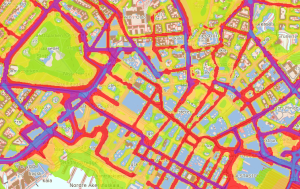Noise is a problem in our society. Traffic noise alone causes so much cardiovascular disease through stress that it is estimated that around 200 Norwegians die of it every year. In addition to traffic noise, we have noise from airports, factories, nightclubs, neighbours, and so forth. Environmental acoustics is about mapping and reducing the effect on people from this unwanted noise.

Topics
- Noise prediction:If you know how noise sources like airplanes and cars radiate sound and you know how these sources are distributed, you can also map how the noise is distributed. These maps can be used for area planning or to redistribute the noise sources to be less disturbing.
- Environmental monitoring, prediction, and control: By continuously monitoring the noise environment in an area, we can also update noise maps in real time and control people’s noise exposure.
- Building acoustics: Sound does not only enter into a room through the air; it can also enter through walls, ceiling, and floor. Building acoustics deals with understanding these sound paths in order to be able to construct quieter buildings.
- Noise reduction technology: The noise from machines and other sources can often be reduced significantly, but the methods to be used can vary between different situations.
- Prediction of noise annoyance: Not all noise is equally annoying. It is therefore important to understand what people are most bothered by, so that we can attack the problem of noise more effectively.
- Hearing protection: In some noisy environments, such as factories, workshops, and oil platforms, it is difficult to reduce noise to safe levels. In these cases, people’s hearing still need to be protected effectively.

Courses at NTNU
- TTT4180 Technical Acoustics: General introductory course to acoustics, which also contains some building acoustics and environmental acoustics.
- TTT4250 Acoustical Measurement Techniques: Provides background for typical measurement tasks in different fields of acoustics, such as environmental acoustics.
- TTT4565 Acoustics, Specialisation course: Contains the module TTT17 Environmental Acoustics. In this module, the topics are methods for calculation and measurement, the effect of noise on people, annoyance, hearing and hearing damage, communication in noise, sound propagation, conditions in room acoustics, and noise reduction technology. The course covers both work-related noise and noise from outdoor sources such as road noise and aircraft noise.
- Additional PhD-level courses are also available.



